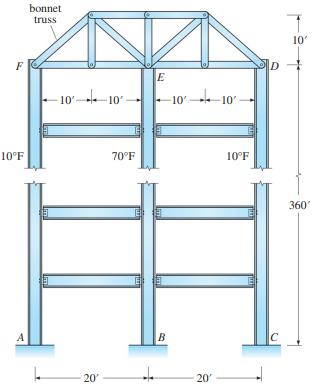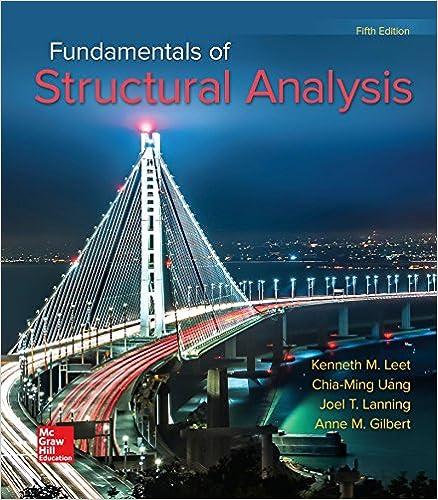The tall building in Figure P9.49 is constructed of structural steel. The exterior columns, which are uninsulated,
Question:
The tall building in Figure P9.49 is constructed of structural steel. The exterior columns, which are uninsulated, are exposed to the outside ambient temperature. To reduce the differential vertical displacements between the interior and exterior columns due to temperature differences between the interior and exterior of the building, a bonnet truss has been added at the top of the building. For example, if a bonnet truss was not used to restrain the outer columns from shortening in the winter due to a \(60^{\circ} \mathrm{F}\) temperature difference between the interior and exterior columns, points \(D\) and \(F\) at the top of the exterior columns would move downward \(1.68 \mathrm{in}\). relative to the top of the interior column at point \(E\). Displacements of this magnitude in the upper stories would produce excessive slope of the floor and would damage the exterior facade.
If the temperature of interior column \(B E\) is \(70^{\circ} \mathrm{F}\) at all times but the temperature of the exterior columns in winter drops to \(10^{\circ} \mathrm{F}\), determine \((a)\) the forces created in the columns and the truss bars by the temperature differences and \((b)\) the vertical displacements of the tops of the columns at points \(D\) and \(E\). Slotted truss connections at \(D\) and F have been designed to act as rollers and transmit vertical force only, and the connection at \(E\) is designed to act as a pin. The shear connections between the beam webs and the columns may be assumed to act as hinges.
Given: \(E=29,000 \mathrm{kips} / \mathrm{in} .^{2}\). The average area of the interior column is \(42 \mathrm{in} .^{2}\) and \(30 \mathrm{in} .^{2}\) for the exterior columns. The areas of all members of the truss are \(20 \mathrm{in.}^{2}\). The coefficient of temperature expansion \(\alpha=6.5 \times 10^{-6}\) (in./in.) \(/{ }^{\circ}\) F. Note: The interior columns must be designed for both the floor loads and the compression force created by the temperature differential.

Step by Step Answer:

Fundamentals Of Structural Analysis
ISBN: 9780073398006
5th Edition
Authors: Kenneth Leet, Chia-Ming Uang, Joel Lanning





